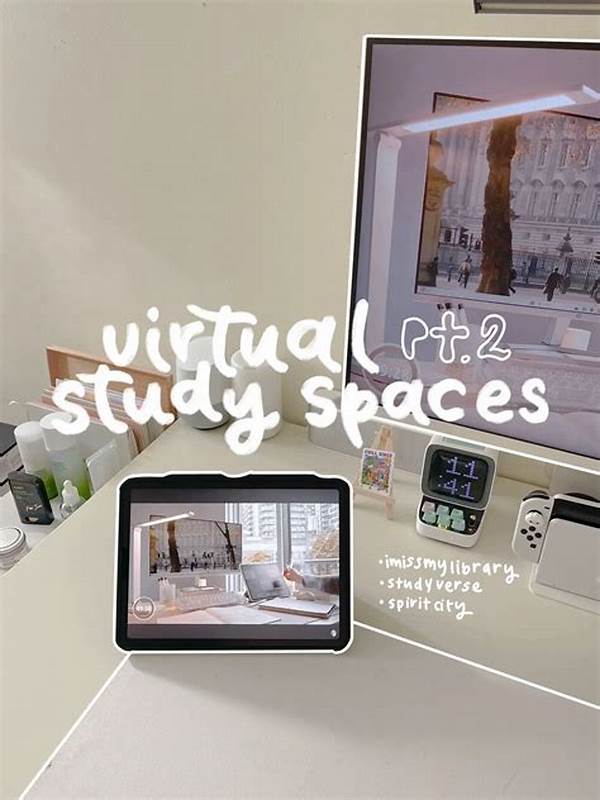In an ever-evolving educational landscape, creating study environments conducive to maintaining concentration stands as a pivotal priority. The ability of students and professionals alike to concentrate is paramount in navigating the challenges and expectations pervasive in academic and professional realms. Therefore, the implementation of strategies aimed at enhancing focus in study spaces is indispensable. This article aims to explore methodologies for improving concentration by meticulously curating an environment that fosters undivided attention.
Read Now : Specialized Classes For High-demand Tech Skills
Creating an Optimal Study Environment
The concept of enhancing focus in study spaces requires a multifaceted approach that includes consideration of both the physical and psychological components of a conducive study environment. The arrangement of furniture, for instance, should accommodate comfort and accessibility. Comfortable seating, adequate lighting, and the availability of necessary study materials play essential roles in keeping distractions at bay. Additionally, psychological elements—such as the presence of calming colors and the elimination of electronic distractions—are equally significant. The integration of visual simplicity can reduce cognitive overload, thus promoting a healthier focus. Moreover, implementing structured time management techniques, like the Pomodoro Technique, aids in maintaining sustained concentration by segmenting study sessions into focused intervals. These strategies, when applied collectively, form the backbone of effective study spaces that emphasize the importance of dedication, concentration, and academic resilience.
Strategies to Enhance Focus
1. Environmental Control: Enhancing focus in study spaces necessitates control over environmental stimuli. Minimizing auditory distractions through the use of noise-canceling headphones or background white noise can prevent interruptions.
2. Ergonomic Furniture: Proper seating and desk arrangements are crucial. Ergonomically designed furniture promotes good posture and ensures comfort during prolonged study sessions, contributing positively to focus enhancement.
3. Lighting Quality: The importance of lighting cannot be overstated. Natural light is ideal, but if unavailable, adjustable artificial lighting can help reduce eye strain and foster an inviting study atmosphere, advancing concentration.
4. Minimalist Design: A clutter-free environment aids in mental clarity. Reducing unnecessary items within the study area ensures that cognitive resources remain dedicated to studying rather than organizing or sifting through clutter.
5. Technological Aids: Utilizing digital tools such as focus apps and online blockers can drastically reduce digital distractions, a common impediment to concentrating in modern study environments.
Psychological Factors in Concentration
The psychological dimension of enhancing focus in study spaces is as critical as the physical setup. Cognitive load theory suggests that an overload of new information can hinder learning, thereby emphasizing the need for structured learning materials and techniques. Adopting mindfulness practices, such as meditation and structured breathing exercises, reinforces mental agility and aids in refocusing attention. Additionally, the practice of setting clear, achievable goals serves to align motivations with actions, further promoting concentration. Furthermore, incorporating regular breaks into study routines can rejuvenate cognitive capacity, ultimately supporting sustained focus over prolonged periods. Collectively, these strategies underscore the psychological underpinnings crucial for effective concentration.
Read Now : Construction Skills Development Workshops
Incorporating Technology in Study Spaces
The integration of technological advancements is pivotal for enhancing focus in study spaces. Applications that schedule study periods, issue reminders, and block distracting content on digital devices contribute substantially to maintaining uninterrupted focus. Advanced educational technologies, such as virtual reality, are also emerging as tools that create immersive learning experiences, effectively engaging the learner and enhancing attention spans. Additionally, the use of smart lighting systems can dynamically adjust light intensity and color, fostering an environment conducive to studying. These technological interventions align with contemporary educational paradigms by enhancing focus through an adaptive learning environment driven by innovation and interaction.
Role of Personalization
Personalization is a key factor when addressing the unique ways in which individuals focus. Customizing study spaces to cater to personal preferences can significantly impact the effectiveness of concentration strategies. The psychological comfort derived from a personally curated space aids in reducing anxiety and enhancing motivation. Attention to individual preferences, such as visual aesthetics, audible environments, and organizational setups, allows for an intrinsically motivating setting conducive to concentration. Personalization effectively bridges the gap between external and internal motivators, empowering individuals to take charge of their learning journey through a customized approach that stimulates both intrinsic and extrinsic sources of focus.
The Impact of Color Psychology
The strategic use of color within a study environment is significant in enhancing focus in study spaces. Colors can evoke specific psychological responses, and understanding these responses allows for the creation of an atmosphere that naturally encourages concentration. For instance, blue hues are noted for their calming effect, promoting mental clarity and focus, while green shades can reduce anxiety and foster positivity. Red, on the other hand, is used sparingly as it can incite alertness. Curating a study environment with mindful application of color theory can thus optimize the cognitive and emotional backdrop necessary for committing to focused study sessions.
Summary and Conclusion
In summary, enhancing focus in study spaces necessitates an integrative approach encompassing environmental, psychological, and technological strategies. By carefully arranging physical spaces to minimize distractions and optimize comfort, individuals can significantly improve their ability to concentrate. Psychological techniques such as mindfulness and goal-setting further bolster concentration efforts, while personalization caters to individual needs and preferences. Additionally, the inclusion of innovative technologies meets the demands of modern education, providing students and professionals access to tools that maintain uninterrupted focus. Collectively, these strategies form a comprehensive framework for fostering optimal study spaces, championing the pursuit of knowledge, productivity, and intellectual growth.
